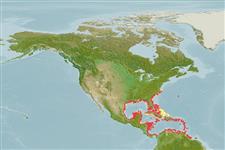>
Gobiiformes (Gobies) >
Gobiidae (Gobies) > Gobionellinae
Etymology: Evorthodus: Greek, eu = good + Greek, ortho = right + Greek, odous = teeth (Ref. 45335).
More on author: Girard.
Environment: milieu / climate zone / depth range / distribution range
Ecología
marino; agua dulce; salobre demersal; anfidromo (Ref. 46888). Subtropical; 20°C - 30°C (Ref. 2059); 40°N - 7°N
Western Atlantic: Chesapeake Bay, USA and northern Gulf of Mexico to northern South America; absent in the Bahamas, but present in Greater Antilles.
Tamaño / Peso / Age
Maturity: Lm ? range ? - ? cm
Max length : 15.0 cm TL macho / no sexado; (Ref. 26340)
Espinas dorsales (total): 6; Radios blandos dorsales (total): 11; Espinas anales 0; Radios blandos anales: 12. Caudal fin large and bluntly pointed with dark lyre-shaped mark on base consisting of 2 dark spots separated by pale central area. Snout very short, mouth small and inferior. Adults have first 3 or 4 dorsal fin spines elongate, reaching from third to sixth ray of second dorsal in females, to base of caudal peduncle in males. Predorsal area and top of head scaled as far forward as eye (Ref. 26938).
Occur mainly in muddy backwaters of bays and estuaries, often in foul waters. Also found on muddy bottoms of fresh water (Ref. 13628).
Life cycle and mating behavior
Madurez | Reproducción | Puesta | Huevos | Fecundidad | Larva
Benthic spawner.
Robins, C.R. and G.C. Ray, 1986. A field guide to Atlantic coast fishes of North America. Houghton Mifflin Company, Boston, U.S.A. 354 p. (Ref. 7251)
IUCN Red List Status (Ref. 130435)
Threat to humans
Harmless
Human uses
Más información
ReferenciasAcuiculturaPerfil de acuiculturaRazasGenéticaElectrophoresesheritabilidadEnfermedadesProcesamientoNutrientsMass conversion
Herramientas
Special reports
Download XML
Fuentes de Internet
Estimates based on models
Preferred temperature (Ref.
123201): 23.5 - 28.2, mean 27.1 °C (based on 636 cells).
Phylogenetic diversity index (Ref.
82804): PD
50 = 0.7500 [Uniqueness, from 0.5 = low to 2.0 = high].
Bayesian length-weight: a=0.00977 (0.00442 - 0.02163), b=3.05 (2.86 - 3.24), in cm total length, based on LWR estimates for this (Sub)family-body shape (Ref.
93245).
Nivel trófico (Ref.
69278): 3.5 ±0.5 se; based on size and trophs of closest relatives
Resiliencia (Ref.
120179): Alto, población duplicada en un tiempo mínimo inferior a 15 meses (Preliminary K or Fecundity.).
Fishing Vulnerability (Ref.
59153): Low vulnerability (10 of 100).
